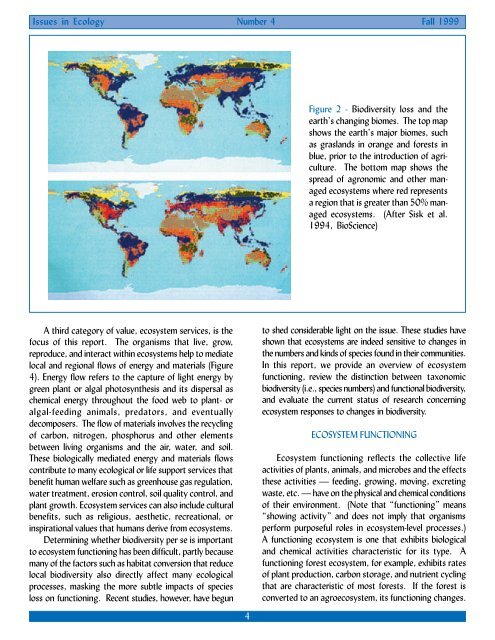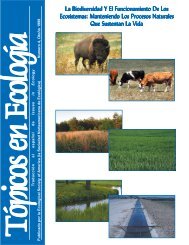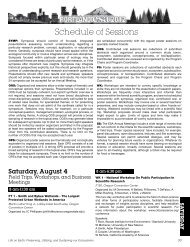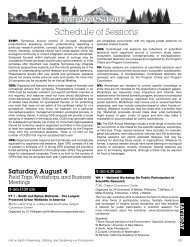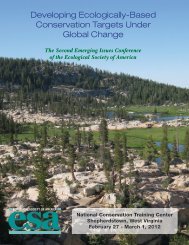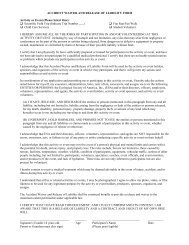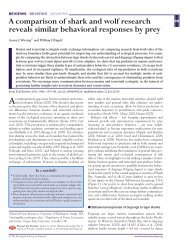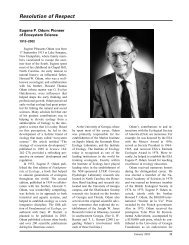Biodiversity and Ecosystem Functioning - Ecological Society of ...
Biodiversity and Ecosystem Functioning - Ecological Society of ...
Biodiversity and Ecosystem Functioning - Ecological Society of ...
Create successful ePaper yourself
Turn your PDF publications into a flip-book with our unique Google optimized e-Paper software.
Issues in Ecology Number 4 Fall 1999<br />
A third category <strong>of</strong> value, ecosystem services, is the<br />
focus <strong>of</strong> this report. The organisms that live, grow,<br />
reproduce, <strong>and</strong> interact within ecosystems help to mediate<br />
local <strong>and</strong> regional flows <strong>of</strong> energy <strong>and</strong> materials (Figure<br />
4). Energy flow refers to the capture <strong>of</strong> light energy by<br />
green plant or algal photosynthesis <strong>and</strong> its dispersal as<br />
chemical energy throughout the food web to plant- or<br />
algal-feeding animals, predators, <strong>and</strong> eventually<br />
decomposers. The flow <strong>of</strong> materials involves the recycling<br />
<strong>of</strong> carbon, nitrogen, phosphorus <strong>and</strong> other elements<br />
between living organisms <strong>and</strong> the air, water, <strong>and</strong> soil.<br />
These biologically mediated energy <strong>and</strong> materials flows<br />
contribute to many ecological or life support services that<br />
benefit human welfare such as greenhouse gas regulation,<br />
water treatment, erosion control, soil quality control, <strong>and</strong><br />
plant growth. <strong>Ecosystem</strong> services can also include cultural<br />
benefits, such as religious, aesthetic, recreational, or<br />
inspirational values that humans derive from ecosystems.<br />
Determining whether biodiversity per se is important<br />
to ecosystem functioning has been difficult, partly because<br />
many <strong>of</strong> the factors such as habitat conversion that reduce<br />
local biodiversity also directly affect many ecological<br />
processes, masking the more subtle impacts <strong>of</strong> species<br />
loss on functioning. Recent studies, however, have begun<br />
4<br />
Figure 2 - <strong>Biodiversity</strong> loss <strong>and</strong> the<br />
earth’s changing biomes. The top map<br />
shows the earth’s major biomes, such<br />
as grasl<strong>and</strong>s in orange <strong>and</strong> forests in<br />
blue, prior to the introduction <strong>of</strong> agriculture.<br />
The bottom map shows the<br />
spread <strong>of</strong> agronomic <strong>and</strong> other managed<br />
ecosystems where red represents<br />
a region that is greater than 50% managed<br />
ecosystems. (After Sisk et al.<br />
1994, BioScience)<br />
to shed considerable light on the issue. These studies have<br />
shown that ecosystems are indeed sensitive to changes in<br />
the numbers <strong>and</strong> kinds <strong>of</strong> species found in their communities.<br />
In this report, we provide an overview <strong>of</strong> ecosystem<br />
functioning, review the distinction between taxonomic<br />
biodiversity (i.e., species numbers) <strong>and</strong> functional biodiversity,<br />
<strong>and</strong> evaluate the current status <strong>of</strong> research concerning<br />
ecosystem responses to changes in biodiversity.<br />
ECOSYSTEM FUNCTIONING<br />
<strong>Ecosystem</strong> functioning reflects the collective life<br />
activities <strong>of</strong> plants, animals, <strong>and</strong> microbes <strong>and</strong> the effects<br />
these activities — feeding, growing, moving, excreting<br />
waste, etc. — have on the physical <strong>and</strong> chemical conditions<br />
<strong>of</strong> their environment. (Note that “functioning” means<br />
“showing activity” <strong>and</strong> does not imply that organisms<br />
perform purposeful roles in ecosystem-level processes.)<br />
A functioning ecosystem is one that exhibits biological<br />
<strong>and</strong> chemical activities characteristic for its type. A<br />
functioning forest ecosystem, for example, exhibits rates<br />
<strong>of</strong> plant production, carbon storage, <strong>and</strong> nutrient cycling<br />
that are characteristic <strong>of</strong> most forests. If the forest is<br />
converted to an agroecosystem, its functioning changes.


